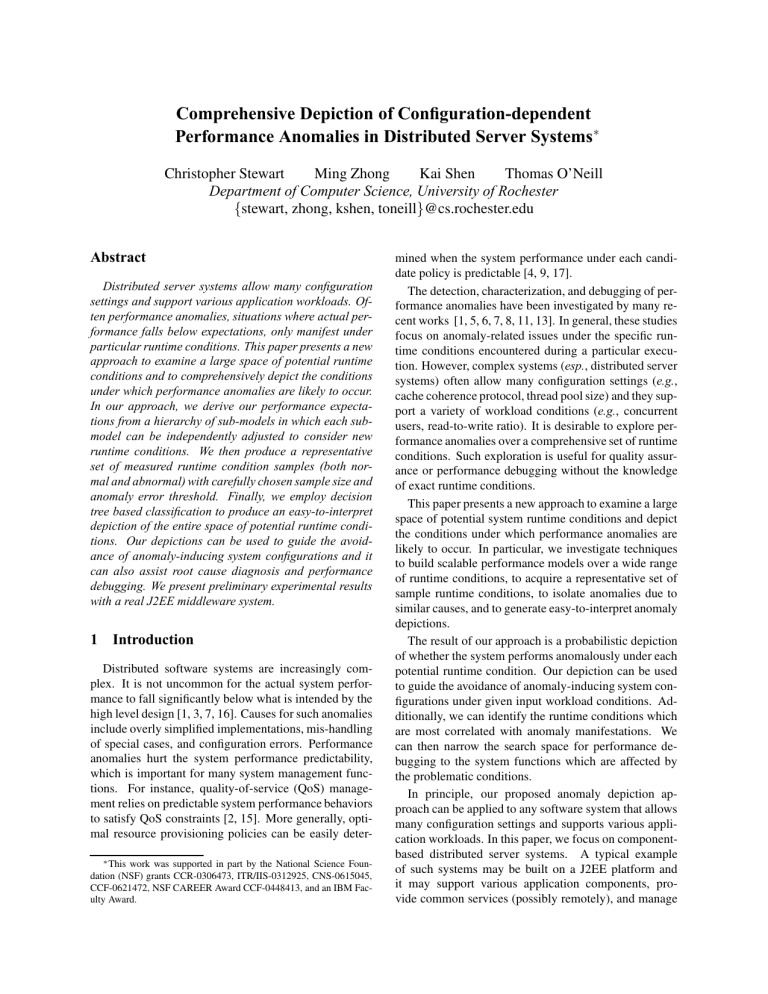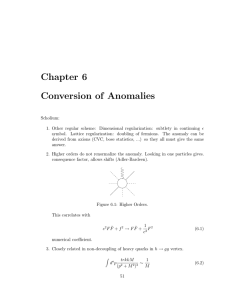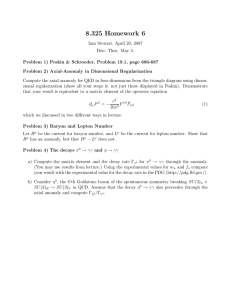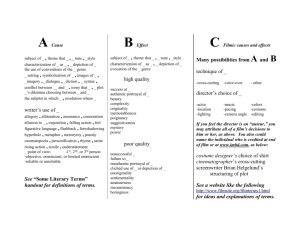Comprehensive Depiction of Configuration-dependent Performance Anomalies in Distributed Server Systems
advertisement

Comprehensive Depiction of Configuration-dependent
Performance Anomalies in Distributed Server Systems∗
Christopher Stewart
Ming Zhong
Kai Shen
Thomas O’Neill
Department of Computer Science, University of Rochester
{stewart, zhong, kshen, toneill}@cs.rochester.edu
Abstract
Distributed server systems allow many configuration
settings and support various application workloads. Often performance anomalies, situations where actual performance falls below expectations, only manifest under
particular runtime conditions. This paper presents a new
approach to examine a large space of potential runtime
conditions and to comprehensively depict the conditions
under which performance anomalies are likely to occur.
In our approach, we derive our performance expectations from a hierarchy of sub-models in which each submodel can be independently adjusted to consider new
runtime conditions. We then produce a representative
set of measured runtime condition samples (both normal and abnormal) with carefully chosen sample size and
anomaly error threshold. Finally, we employ decision
tree based classification to produce an easy-to-interpret
depiction of the entire space of potential runtime conditions. Our depictions can be used to guide the avoidance of anomaly-inducing system configurations and it
can also assist root cause diagnosis and performance
debugging. We present preliminary experimental results
with a real J2EE middleware system.
1 Introduction
Distributed software systems are increasingly complex. It is not uncommon for the actual system performance to fall significantly below what is intended by the
high level design [1, 3, 7, 16]. Causes for such anomalies
include overly simplified implementations, mis-handling
of special cases, and configuration errors. Performance
anomalies hurt the system performance predictability,
which is important for many system management functions. For instance, quality-of-service (QoS) management relies on predictable system performance behaviors
to satisfy QoS constraints [2, 15]. More generally, optimal resource provisioning policies can be easily deter∗ This work was supported in part by the National Science Foundation (NSF) grants CCR-0306473, ITR/IIS-0312925, CNS-0615045,
CCF-0621472, NSF CAREER Award CCF-0448413, and an IBM Faculty Award.
mined when the system performance under each candidate policy is predictable [4, 9, 17].
The detection, characterization, and debugging of performance anomalies have been investigated by many recent works [1, 5, 6, 7, 8, 11, 13]. In general, these studies
focus on anomaly-related issues under the specific runtime conditions encountered during a particular execution. However, complex systems (esp., distributed server
systems) often allow many configuration settings (e.g.,
cache coherence protocol, thread pool size) and they support a variety of workload conditions (e.g., concurrent
users, read-to-write ratio). It is desirable to explore performance anomalies over a comprehensive set of runtime
conditions. Such exploration is useful for quality assurance or performance debugging without the knowledge
of exact runtime conditions.
This paper presents a new approach to examine a large
space of potential system runtime conditions and depict
the conditions under which performance anomalies are
likely to occur. In particular, we investigate techniques
to build scalable performance models over a wide range
of runtime conditions, to acquire a representative set of
sample runtime conditions, to isolate anomalies due to
similar causes, and to generate easy-to-interpret anomaly
depictions.
The result of our approach is a probabilistic depiction
of whether the system performs anomalously under each
potential runtime condition. Our depiction can be used
to guide the avoidance of anomaly-inducing system configurations under given input workload conditions. Additionally, we can identify the runtime conditions which
are most correlated with anomaly manifestations. We
can then narrow the search space for performance debugging to the system functions which are affected by
the problematic conditions.
In principle, our proposed anomaly depiction approach can be applied to any software system that allows
many configuration settings and supports various application workloads. In this paper, we focus on componentbased distributed server systems. A typical example
of such systems may be built on a J2EE platform and
it may support various application components, provide common services (possibly remotely), and manage
application-level protocols to access storage and remote
services. Additionally, these systems are often deployed
in distributed environments with high-concurrency workload conditions.
2 Performance Expectations for Wide
Ranges of Configuration Settings
It is challenging to produce accurate performance expectations for distributed server systems due to their inherent complexity. Recent work by Urgaonkar et al.
models the performance of multi-tier distributed services
using a network of queues [20]. Our own past work constructed performance prediction models for componentbased distributed systems [17]. However, neither of
these models consider the performance effects of wide
ranges of configuration settings. Configuration settings
can have complex effects on the workload of individual system functions (e.g., component invocation, distributed caching, etc.) which can significantly affect the
overall system performance.
To consider wide ranges of configuration settings, we
derive performance expectations from a hierarchy of submodels. Each sub-model predicts a workload property
from lower-level properties according to the effects of
system functions under given configuration settings. At
the highest level of our hierarchy, the predicted workload
properties are the desired performance expectations. The
workload properties at the lowest-levels in our model
are canonical workload properties that can be independently measured with no concern of the system functions
or their configuration settings. These properties include
component CPU usage and inter-component communication in terms of bandwidth usage and blocking send/receive count.
The architecture of hierarchical sub-models allows us
to manage increasing system complexity with multiple
independent smaller modules. More specifically, submodels can be independently adjusted to accommodate
new system configuration settings. Further, the intermediate workload predictions can also be examined for performance anomalies. In particular, an anomalous workload detected in one sub-model but not in its input submodels can narrow the scope of potential problematic
system functions during debugging.
Figure 1 illustrates our model that considers several
system functions and configuration settings that have significant impact upon performance. The system functions
we consider include distributed caching, remote component invocation, distributed component placement, and
server concurrency management. Implementation and
configuration errors related to these functions are most
likely to cause large performance degradation. While our
%
'
&
&
#
&
$
&
&
&
!"
!"
Figure 1: A hierarchy of sub-models. Low-level workload properties are assembled into higher-level properties according to the performance impact of configuration settings.
high level model should be generally applicable to most
component-based distributed server systems, our specific
model construction targets J2EE-based distributed systems and our effort builds on our earlier work in [17].
We omit modeling details in this paper due to space limitation.
3 Anomaly Sample Collection
For complex distributed server systems, there is often a large space of possible runtime conditions in terms
of system configurations and workload condition. Conceptually, the runtime condition space has multiple dimensions where each system configuration and workload
condition that can be independently adjusted is a dimension. We choose sample conditions from the space of
potential runtime conditions in a uniformly random fashion. We then compare measured system performance
with our model-based expectation under these conditions. Anomalous conditions are those at which measured performance trails the expectation by at least a
certain threshold. Below we present techniques to determine the size of our random sample and to select the
anomaly error threshold.
#1. Sample size. Anomaly checking at too many sample conditions may consume an excessive amount of time
and resource (due to performance measurement and expectation model computation at all sampled conditions).
At the same time, we must have a sufficient sample size
in order to acquire a representative view of performance
anomalies over the complete runtime condition space.
Our approach is to examine enough sample conditions
so that key cumulative sample statistics (e.g., average
and standard deviation of sample performance expectation errors) converge to stable levels.
#2. Anomaly error threshold. Another important ques-
tion using this approach.
Expectation error
100%
←knee
80%
Response time
Throughput
4 Performance Anomaly Depiction
←knee
60%
←knee
40%
←knee
←knee
20%
0%
0
400
800
1200
1600
2000
Sample runtime conditions (sorted on expectation error)
Figure 2: Response time and throughput expectation errors of 2000 sampled runtime conditions sorted in decreasing order. We mark knee points on the two curves
for possible identification of the anomaly error threshold.
tion is ”How much deviation between the measured performance and the expectation counts for an anomaly?”
The determination of anomaly error threshold depends
on the eventual purpose of anomaly depiction. When the
depiction result is used for the avoidance of anomalyinducing conditions, the anomaly error threshold is usually specified at a tolerance level of expectation error by
the system administrator. When the depiction result is
used for performance debugging, it is important for the
anomaly sampling to contain minimal noises that are not
related to targeted bugs.
To minimize the noises, we utilize an observation
that performance anomaly manifestations due to the
same cause (e.g., an implementation bug or a misconfiguration) are more likely to share similar error magnitude than unrelated anomaly manifestations do. In
our approach, we sort all sampled conditions according to their performance expectation errors. We then
look for knee points on the performance expectation error curve, which serve as likely thresholds attributing
anomaly manifestations to different hidden causes. Onedimensional clustering algorithms (e.g., k-means [10])
can be used to determine knee points in a given set of
expectation errors — the knee points are those thresholds that separate different error groups generated by the
clustering algorithm.
Figure 2 illustrates an example of knee points discovered on the error curves of sample conditions sorted in
the order of expectation errors. When multiple knee
points are available, we can choose a low error threshold to capture multiple bugs in one anomaly depiction.
Alternatively, we can choose a high error threshold in order to focus on a few severe bugs in one depiction, fix
them, and then characterize more bugs in later rounds of
anomaly depiction. Conceivably, we can choose a maximum and minimum error threshold to target a specific
bug, however we have not yet investigated noise reduc-
From a representative set of sampled runtime conditions (each labeled “normal” or “anomalous”), we study
the problem of deriving a comprehensive performance
anomaly depiction. The depiction is essentially a classifier of system and workload configurations that partitions
the runtime condition space into normal and anomalous
regions of hyper-rectangular shapes. There has been a
great number of well-proven classification techniques,
such as naive Bayes classifiers, perceptrons, decision
trees, neural networks, Bayesian networks, support vector machines, and hidden Markov models. We use decision trees to build our performance depiction because
they have the following desirable properties.
• Easy interpretability. Compared with other “blackbox” classification techniques (e.g., neural networks, support vector machines) where the explanation for the results is too complex to be comprehended, decision trees can be easily understood as
IF-THEN rules or graphs, which provide great assistance to further debugging efforts.
• Prior knowledge free. Decision trees do not require
any prior knowledge on underlying models, data
distributions, or casual relationships, which are often not available in our studied systems. In comparison, hidden Markov models and Bayesian networks
typically need to have a preliminary model before
they learn to parameterize the model.
• Efficiency and robustness. Decision trees can
quickly handle a large amount of noisy data with
both numerical and categorical elements, requiring
little preparation work such as normalization, missing value prediction, etc. Such ease of implementation is especially desirable when we consider a large
number of factors on the system performance.
We use the Iterative Dichotomiser 3 (ID3) algorithm [12] to generate our performance anomaly depiction. Our depiction is a decision tree that classifies a
vector of workload conditions and system configurations
into one of two target classes — “normal” or “anomalous”. In ID3, the decision tree is generated in a topdown way by iteratively selecting an attribute that best
classifies current training samples, partitioning samples
based on their corresponding values of the attribute, and
constructing a subtree for each partition until current
samples all fall into the same category. Specifically, the
tree-generation algorithm uses information gain to select
an attribute that is most effective in classifying training
samples. The information gain of an attribute a over
Performance Debugging
a=0
a
Anomaly Avoidance
a=1
b
Anomalous
80% prob.
b=0~3
c=0
b= 4~8
Normal
75% prob.
a
a=0
d
c
c=1
e
a=1
b
b=8
b=0
f
m
Anomalous
90% prob.
Interpretation amenable
for human understanding
Debugging hints
IF a=0 THEN likely anomaly
IF a=1 ^ b=0~3 THEN likely normal
IF a=1 ^ b=4~8 THEN likely anomaly
Whitebox Usage
Blackbox
transformation
Yes
Q: will a set of runtime
conditions cause anomaly?
No
Blackbox usage
Figure 3: Decision tree-based performance anomaly depiction.
dataset S is defined as follows.
Gain(S, a) = H(S) −
X
v∈values(a)
|Sv |
· H(Sv )
|S|
where Sv is the subset of S whose values of attribute a
are v. H(S) is the information entropy of S. Intuitively,
information gain measures how much data impurity is
reduced by partitioning S based on attribute a.
As illustrated by Figure 3, the primary usage of our
performance anomaly depiction falls into the following
two categories.
• White-box depiction usage — performance debugging. Performance anomaly depiction is used to
make correlations between performance problems
and system functions. For this usage, human interpretability of the depiction is most important. As a
result, we stop growing the decision tree at a certain
depth so that the result can be easily understood.
• Black-box depiction usage — anomaly avoidance.
Performance anomaly depiction is used as an oracle,
which answers whether a given system configuration (with current input workload) leads to anomaly
or not. For this purpose, the depiction accuracy is
paramount.
5 Preliminary Experimental Results
We experiment with JBoss — a commercial-grade
open-source J2EE application server. We consider 8
runtime conditions: cache coherence protocols, component invocation method, component placement strategy,
thread pool size, application type, concurrent users, read/write mix, and database access mix. These conditions
combine to form over 7 million potential runtime conditions. In our experiments, JBoss may service the application logic of RUBiS [14], StockOnline [18], or TPCW [19] depending upon runtime settings. Our tests run
on a small cluster of four machines each with a 2.66 GHz
P4 processor and 512 MB of memory.
Avoidance Figure 4 provides an illustration of full depiction result for the purpose of anomaly avoidance. We
evaluate the accuracy of our decision tree by comparing the prediction result with measured result on some
additional randomly chosen system runtime conditions.
We examine two metrics: precision (the proportion of
real depicted anomalies in all depicted anomalies) and
recall ( the proportion of real depicted anomalies in all
real anomalies). There is a fundamental trade-off between precision and recall in that attempts to increase recall tend to enlarge the depicted anomaly region, which
may mistakenly include normal settings and hence reduce precision. Attempts to increase precision typically
exclude some real anomalous points from the depicted
anomaly region and thus decrease recall. Such a tradeoff can be exploited by setting different anomaly error
threshold. At the anomaly error threshold of 30% (i.e.,
performance deviation of 30% or more from the expectation is considered an anomaly), our depiction precision
is 89% and recall is 83%. This result indicates a high
accuracy of our depiction result.
// %"+
# !$
$
,!
)
)
% $$
!+ /+
#!
&
(
%
'
%- ( .
,( .
!"#
*
*
!,
#
(
% !!
#!
)
!( .
,
!%!,,
*
#/
)
*
%/
#,
)
*
+,
" ,#
,!
,
!" ,%
!! !/
#
$
!
#
%
(
"
$%&
$#'(')&
$*&
!
#
%
(
"
$*')&
$#'%'(&
!
"
#
%
(
$#'%'*&
$(')&
!
#
%
(
"
$)&
$#'%'*&
$(&
Figure 4: The full depiction tree for anomaly avoidance.
Performance Debugging We also explore the debugging use of our depiction result. For each anomalous leaf
node, the path leading back to the decision tree root represents a series of anomaly-correlated conditions (system
configurations and workload conditions). Such knowledge may narrow down the debugging scope and provide hints to human debuggers. As noted in Section 4,
the decision trees we generated for debugging have artificially low depths. This is to make the depiction results
amenable for human understanding. Even with the aid of
anomaly depiction, it is important to note that the actual
discovery of each anomaly root cause is still a substantially manual process. In our investigation, the human
debugger has at his disposal a set of system tracing and
debugging tools at both the EJB application server level
and inside the operating system kernel.
Our depiction-aided debugging has uncovered three
performance problems in the system: a component placement configuration error due to ambiguous J2EE specification, a mis-handled exception in the JBoss thread
management, and a potential deadlock in distributed concurrency management. Due to space limitation, we only
show the debugging of the first problem in this paper.
Figure 5 shows the three-level decision tree produced
for debugging. We observe a strong correlation between performance anomaly and four specific component placement strategies. A closer look revealed that
in all of these correlated placement strategies, a majority of the components were placed on node #2 in our
testbed. We inserted trace points into the system to monitor the network traffic and component lookup behaviors
concerning node #2. We noticed that component lookup
procedures executed correctly, but that subsequent invocations were never performed on node #2 and were instead routed to node #1. We traced the abnormal behavior of the lookup function to a mis-understood J2EE
specification by the programmer. The component lookup
procedure returns a pointer to a component instance in
the system, but not necessarily at the node upon which
the lookup is performed. In particular, our node #2 was
mis-configured to route component invocations to node
#1 despite the programmer intention for components to
Figure 5: A three-level decision tree produced for debugging. Non-leaf nodes represent system configurations or
workload conditions while leaf nodes represent decision
points. The value inside each decision point indicates the
likelihood of performance anomalies within that decision
point’s region. For brevity, we only show the decision
points in the tree that are substantially anomalous.
execute on node #2. The increased queuing delay at node
#1 caused response time and throughput degradation beyond what was expected by our performance models.
6 Conclusion and Discussions
This paper presents a new approach to comprehensively depict performance anomalies over a large space
of potential runtime conditions. We also demonstrate
the practical benefits of such comprehensive anomaly depiction, in terms of avoiding anomaly-inducing runtime
conditions and of assisting performance debugging. Below we discuss several additional issues.
First, our configuration-dependent anomaly depiction
approach targets performance anomalies that are correlated with static system configurations and workload
conditions. For instance, our approach may find a RMI
(remote method invocation) performance anomaly that is
triggered under a particular component placement policy.
However, a performance bug that only manifests when
several different types of RMIs are made in a particular
order may not be discovered by our methods. Although
this is an important limitation, we believe the proposed
approach is still effective for discovering many existing
performance anomalies, as demonstrated in our experimental results.
Second, constructing performance expectations over
many system configurations for a target system is still a
substantially manual effort in our approach. The performance expectation model itself may not be accurate at all
considered runtime conditions and such inaccuracy may
also be a source for “performance anomalies”. While
these “anomalies” may overshadow or even conceal real
problems in system implementation and configuration,
we argue that our anomaly depiction can similarly assist
the discovery and correction of the expectation model
inaccuracies. Since the performance model is typically
much less complex than the system itself, its analysis and
debugging should also be much easier.
Our work is ongoing. In the short-term, we plan to extend the range of runtime conditions (esp. system configurations) supported by our performance model. We also
hope to expand our empirical study to comprehensively
depict anomalies for other systems. Further anomaly depictions may shed more light into common areas of performance problems in distributed server systems. In the
long-term, we will investigate systematic methods to depict the correlation between performance anomalies and
source code level system components or parameter settings. This capability could further narrow the investigation scope in depiction-driven performance debugging.
Acknowledgment
We would like to thank Arun Iyengar, Arrvindh Shriraman, Jian Yin, and the anonymous referees for helpful
discussions and valuable comments.
References
[1] M.K. Aguilera, J.C. Mogul, J.L. Wiener, P. Reynolds,
and A. Muthitacharoen. Performance Debugging for Distributed Systems of Black Boxes. In Proc. of the 19th
ACM Symp. on Operating Systems Principles, pages 74–
89, Bolton Landing, NY, October 2003.
[2] G. A. Alvarez, E. Borowsky, S. Go, T. H. Romer,
R. Becker-Szendy, R. Golding, A. Merchant, M. Spasojevic, A. Veitch, and J. Wilkes. Minerva: An Automated
Resource Provisioning Tool for Large-Scale Storage Systems. ACM Trans. on Computer Systems, 19(4):483–418,
November 2001.
[7] I. Cohen, J.S. Chase, M. Goldszmidt, T. Kelly, and
J. Symons. Correlating Instrumentation Data to System
States: A Building Block for Automated Diagnosis and
Control. In Proc. of the 6th USENIX Symp. on Operating
Systems Design and Implementation, pages 231–244, San
Francisco, CA, December 2004.
[8] I. Cohen, S. Zhang, M. Goldszmidt, J. Symons, T. Kelly,
and A. Fox. Capturing, Indexing, Clustering, and Retrieving System History. In Proc. of the 20th ACM Symp. on
Operating Systems Principles, pages 105–118, Brighton,
United Kingdom, October 2005.
[9] R.P. Doyle, J.S. Chase, O.M. Asad, W. Jin, and A.M. Vahdat. Model-based Resource Provisioning in a Web Service Utility. In Proc. of the 4th USENIX Symp. on Internet
Technologies and Systems, Seattle, WA, March 2003.
[10] J. B. McQueen. Some methods for classification and
analysis of multivariate observations. In Proc. of the
5th Berkeley Symposium on Mathematical Statistics and
Probability, pages 281 – 297, 1967.
[11] T. Kelly. Detecting Performance Anomalies in Global
Applications. In Proc. of the Second Workshop on Real,
Large Distributed Systems, pages 43–48, San Francisco,
CA, December 2005.
[12] J.R. Quinlan. Induction of Decision Trees. Machine
Learning, 1(1):81–106, 1986.
[13] P. Reynolds, C. Killian, J.L. Wiener, J.C. Mogul, M.A.
Shah, and A. Vahdat. Pip: Detecting the Unexpected in
Distributed Systems. In Proc. of the Third USENIX Symp.
on Networked Systems Design and Implementation, San
Jose, CA, May 2006.
[14] RUBiS: Rice University Bidding System.
.objectweb.org.
http://rubis
[15] K. Shen, H. Tang, T. Yang, and L. Chu. Integrated
Resource Management for Cluster-based Internet Services. In Proc. of the 5th USENIX Symp. on Operating Systems Design and Implementation, pages 225–238,
Boston, MA, December 2002.
[3] P. Barham, A. Donnelly, R. Isaacs, and R. Mortier. Using
Magpie for Request Extraction and Workload Modeling.
In Proc. of the 6th USENIX Symp. on Operating Systems
Design and Implementation, pages 259–272, San Francisco, CA, December 2004.
[16] K. Shen, M. Zhong, and C. Li. I/O System Performance
Debugging Using Model-driven Anomaly Characterization. In Proc. of the 4th USENIX Conf. on File and Storage Technologies, pages 309–322, San Francisco, CA,
December 2005.
[4] J.S. Chase, D.C. Anderson, P.N. Thakar, A.M. Vahdat,
and R.P. Doyle. Managing Energy and Server Resources
in Hosting Centers. In Proc. of the 18th ACM Symp.
on Operating Systems Principles, pages 103–116, Banff,
Canada, October 2001.
[17] C. Stewart and K. Shen. Performance Modeling and System Management for Multi-component Online Services.
In Proc. of the Second USENIX Symp. on Networked Systems Design and Implementation, pages 71–84, Boston,
MA, May 2005.
[5] M. Chen, A. Accardi, E. Kiciman, J. Lloyd, D. Patterson,
A. Fox, and E. Brewer. Path-Based Failure and Evolution Management. In Proc. of the First USENIX Symp.
on Networked Systems Design and Implementation, pages
309–322, San Francisco, CA, March 2004.
[18] The StockOnline Benchmark. http://forge.objectweb.org
/projects/stock-online.
[6] M. Chen, E. Kiciman, E. Fratkin, A. Fox, and E. Brewer.
Pinpoint: Problem Determination in Large, Dynamic Systems. In Proc. of Int’l Conf. on Dependable Systems and
Networks, pages 595–604, Washington, DC, June 2002.
[19] Transaction Processing Performance Council. TPC-W
Web E-Commerce Bencmark. http://www.tpc.org/tpcw.
[20] B. Urgaonkar, G. Pacifici, P. Shenoy, M. Spreitzer, and
A. Tantawi. An Analytical Model for Multi-tier Internet
Services and Its Applications. In Proc. of the ACM SIGMETRICS, pages 291–302, Banff, Canada, June 2005.






